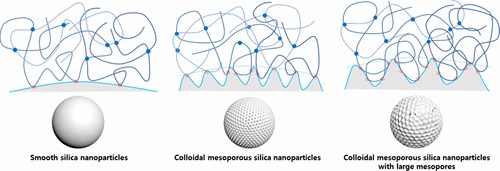当前位置:
X-MOL 学术
›
ACS Appl. Mater. Interfaces
›
论文详情
Our official English website, www.x-mol.net, welcomes your
feedback! (Note: you will need to create a separate account there.)
Colloidal Mesoporous Silica Nanoparticles as Strong Adhesives for Hydrogels and Biological Tissues
ACS Applied Materials & Interfaces ( IF 8.3 ) Pub Date : 2017-09-05 00:00:00 , DOI: 10.1021/acsami.7b09083 Joo-Hyung Kim 1 , Hodae Kim 1 , Youngjin Choi 1 , Doo Sung Lee 1 , Jaeyun Kim 1 , Gi-Ra Yi 1
ACS Applied Materials & Interfaces ( IF 8.3 ) Pub Date : 2017-09-05 00:00:00 , DOI: 10.1021/acsami.7b09083 Joo-Hyung Kim 1 , Hodae Kim 1 , Youngjin Choi 1 , Doo Sung Lee 1 , Jaeyun Kim 1 , Gi-Ra Yi 1
Affiliation

|
Sub-100 nm colloidal mesoporous silica (CMS) nanoparticles are evaluated as an adhesive for hydrogels or biological tissues. Because the adhesion energy is proportional to the surface area of the nanoparticles, the CMS nanoparticles could provide a stronger adhesion between two hydrogels than the nonporous silica nanoparticles. In the case of 50 nm CMS nanoparticles with a pore diameter of 6.45 nm, the maximum adhesion energy was approximately 35.0 J/m2 at 3.0 wt %, whereas the 10 wt % nonporous silica nanoparticle solution showed only 7.0 J/m2. Moreover, the CMS nanoparticle solution had an adhesion energy of 22.0 J/m2 at 0.3 wt %, which was 11 times higher than that of the nonporous nanoparticles at the same concentration. Moreover, these CMS nanoparticles are demonstrated for adhering incised skin tissues of mouse, resulting in rapid healing even at a lower nanoparticle concentration. Finally, the CMS nanoparticles had added benefit of quick degradation in biological media because of their porous structure, which may prevent unwanted accumulation in tissues.
中文翻译:

胶体介孔二氧化硅纳米粒子作为水凝胶和生物组织的强力粘合剂
低于100 nm的胶体介孔二氧化硅(CMS)纳米颗粒被评估为水凝胶或生物组织的粘合剂。因为粘附能与纳米颗粒的表面积成正比,所以CMS纳米颗粒比无孔二氧化硅纳米颗粒可以在两种水凝胶之间提供更强的粘附力。在孔径为6.45nm的50nm CMS纳米颗粒的情况下,在3.0wt%时最大粘附能为约35.0J / m 2,而10wt%的无孔二氧化硅纳米颗粒溶液仅显示7.0J / m 2。而且,CMS纳米颗粒溶液的粘附能为22.0J / m 2。含量为0.3 wt%,是相同浓度下无孔纳米颗粒的11倍。此外,这些CMS纳米粒子被证明可粘附于小鼠切开的皮肤组织,即使在较低的纳米粒子浓度下也能快速愈合。最后,CMS纳米颗粒由于具有多孔结构,还增加了在生物介质中快速降解的优势,这可以防止组织中不必要的积累。
更新日期:2017-09-05
中文翻译:

胶体介孔二氧化硅纳米粒子作为水凝胶和生物组织的强力粘合剂
低于100 nm的胶体介孔二氧化硅(CMS)纳米颗粒被评估为水凝胶或生物组织的粘合剂。因为粘附能与纳米颗粒的表面积成正比,所以CMS纳米颗粒比无孔二氧化硅纳米颗粒可以在两种水凝胶之间提供更强的粘附力。在孔径为6.45nm的50nm CMS纳米颗粒的情况下,在3.0wt%时最大粘附能为约35.0J / m 2,而10wt%的无孔二氧化硅纳米颗粒溶液仅显示7.0J / m 2。而且,CMS纳米颗粒溶液的粘附能为22.0J / m 2。含量为0.3 wt%,是相同浓度下无孔纳米颗粒的11倍。此外,这些CMS纳米粒子被证明可粘附于小鼠切开的皮肤组织,即使在较低的纳米粒子浓度下也能快速愈合。最后,CMS纳米颗粒由于具有多孔结构,还增加了在生物介质中快速降解的优势,这可以防止组织中不必要的积累。





















































 京公网安备 11010802027423号
京公网安备 11010802027423号